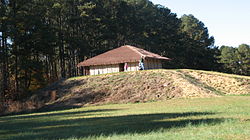Pee Dee (tribe)

Town Creek Mound, a precontact Pee Dee culture site in North Carolina
|
|
| Regions with significant populations | |
|---|---|
|
|
|
| Languages | |
| unknown, likely Siouan languages | |
| Related ethnic groups | |
| Catawba and other Siouan peoples |
The Pee Dee people, also Pedee and Peedee, are American Indians of the Southeast United States. Historically, their population has been concentrated in the Piedmont of present-day South Carolina. In the 17th and 18th centuries, English colonists named the Pee Dee River and the Pee Dee region of South Carolina for the tribe.
Linguists have not identified to which language family the Pedee language belonged, although it was likely a Siouan language, as were the languages of neighboring small tribes in the Piedmont region.
Several organizations, including state recognized tribes, one state recognized group and unrecognized groups, claim descent from Pedee.
The meaning of name Pedee is unknown but is believed to be a Catawba language-term. Anthropologist Frank Speck believed the term may have derived from the Catawba term pi'ri, meaning "something good," or pi'here, meaning "capable," "expert," or "smart."
The Pee Dee culture is an archaeological cultural spanning 1000 to 1500 CE and is divided into the Teal phase (1000–1200), Town Creek phase (1200–1400), and Leak phase (1400–1500). The Pee Dee were part of the South Appalachian Mississippian culture that developed in the region as early as 980 CE, extending into present-day North Carolina and Tennessee. They participated in a widespread trade network that stretched from Georgia to South Carolina, eastern Tennessee, and the mountain and Piedmont regions of North Carolina. The Pee Dee culture had developed in the region as a distinct culture by 980 CE and thrived in the Pee Dee River region of present-day North and South Carolina during the pre-Columbian era. As an example, the Town Creek Indian Mound site in western North Carolina was occupied from about 1150 to 1400 CE.
...
Wikipedia
